For decades, the history of computer science and engineering has largely been told as a story of male geniuses and their groundbreaking innovations. Names like Alan Turing, Bill Gates, and Steve Jobs have become synonymous with the field, while the contributions of women have often been overlooked or outright ignored. However, the reality is that women have played a significant role in the development of computer technology since its earliest days.
From pioneering storing data in binary patterns through weaving, to incredible contributions to the Apollo Moon Missions, women and the work traditionally done by them have been at the forefront of many of the field's most important breakthroughs. Yet their stories remain largely untold, a hidden history that deserves to be recognized and celebrated.
Weaving and the expansion of binary systems
Weaving has traditionally been thought of as "women's work" for many centuries. In many cultures around the world, women were responsible for making cloth for their families and communities, often using simple hand-held looms. Weaving was seen as an important domestic skill, passed down from mother to daughter, and it required patience, attention to detail, and manual dexterity - qualities that were often associated with women.


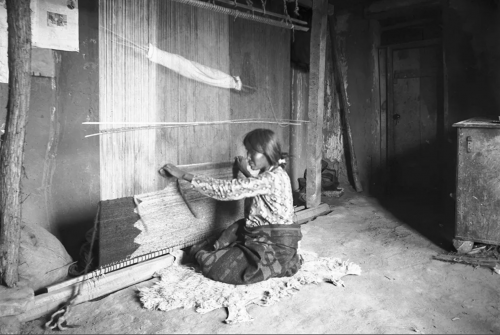
Depiction of ancient Greek loom
Illustration of weaving in Ancient China. Source: National Silk Museum of China
Navajo woman weaving a blanket.
Despite weaving being so integral to society, however, it was often undervalued and underpaid. Women weavers were frequently paid less than men for similar work, and were often excluded from guilds or other professional associations.
The influence of weaving as an art form on the creation of computer science and engineering is rooted in the concept of binary code. Binary code is a system of representing information using only two symbols, typically 0 and 1, and I'm sure you're familiar with it. This system is the foundation of modern computing and is used to represent everything from text and images to complex algorithms.
Most notably, binary code is used in graphics like this to make sure people know something cyberpunk-adjacent is going on
The idea of using a binary code to represent information is not a new one; it's been used in many different cultures throughout history in the art of weaving. Weaving involves the interlacing of threads in a specific pattern to create a textile. In weaving, binary code was used to represent the interlacing of threads in a specific pattern. Each thread in a weave can be thought of as either "on" or "off" depending on its position in the pattern. For example, in a basic plain weave, the weft thread alternates over and under the warp threads, creating a pattern of 1s and 0s. This pattern could be extended to more complex weaves, where different combinations of over and under create more intricate designs.
Weavers would use a system of dots and dashes to represent the 1s and 0s in the pattern. A dot would represent an "on" thread, while a dash would represent an "off" thread. This system of representing patterns allowed weavers to create complex designs using a binary code long before computers existed.
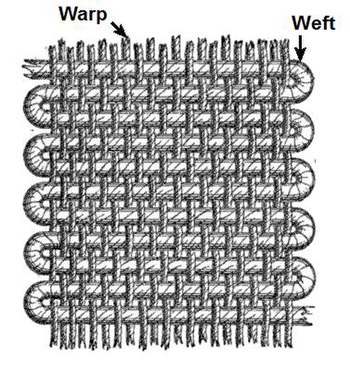

Plain weave, with warp and weft labeled
Example of binary application to pattern of plain weave
As industrialization in weaving picked up, French textile producer Joseph Marie Jacquard thought of using a card that had holes punched to convey this on and off binary pattern so that the process of alternating the treads could be automated by the loom. Enter, the punchcard. The Jacquard Loom used punchcards that consisted of a series of holes that corresponded to the pattern to be woven, and were a revolutionary innovation, allowing complex patterns to be woven quickly and accurately.
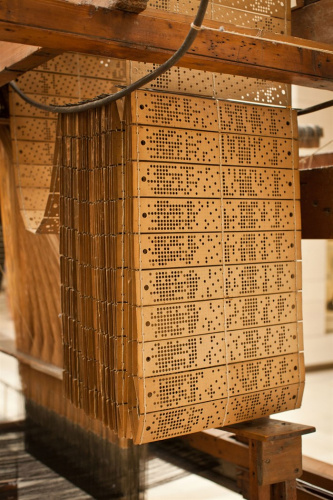
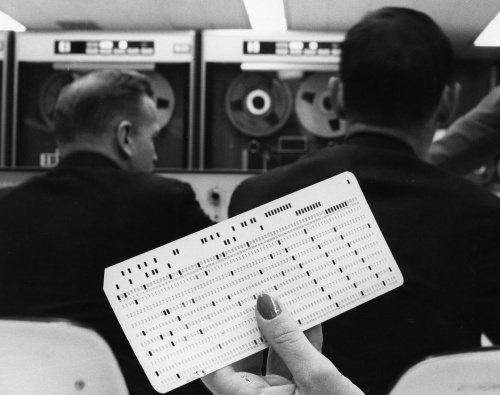
Punchcards used on the Jacquard Loom. Source: Scotland National Museum
Punchcards used in early computers. Source: "Print Punch: by Patrick Fry
The use of punchcards in weaving demonstrated the potential of using machine-readable codes to automate processes and create complex patterns, a concept that would later become important in the development of computing.
Binary code's entrance into computing
In the 19th century, mathematician Ada Lovelace was the first person to recognize the potential of using binary code to represent more than just simple patterns. She saw that it could be used to represent complex mathematical algorithms, and thus laid the foundation for what would become computer programming.
Lovelace was instead primarily influenced by her study of mathematics and her work with Charles Babbage on the design of the Analytical Engine. Babbage envisioned a machine that would be able to perform complex calculations quickly and accurately. Babbage was aware of the Jacquard loom and the use of punched cards to automate the weaving process, and he recognized the potential of this technology for use in his own designs for mechanical calculation machines to input instructions and data into the machine. The machine was never built, but its design inspired Ada Lovelace to keep working.
Babbage's Analytical Engine design
In her notes on the machine, Lovelace emphasized the importance of breaking down complex calculations into simple, step-by-step processes that could be represented using symbols and codes. Lovelace's interest in programming the Analytical Engine led her to study the work of mathematician George Boole, who had developed a system of algebraic logic using only two values, which we now know as Boolean algebra. This system used two values, typically represented as 0 and 1, to represent true and false, or on and off. Lovelace saw the potential of using this binary system to represent more than just simple patterns in weaving or punchcards, but to represent complex mathematical algorithms as well. This has become a fundamental concept in computer science and engineering.
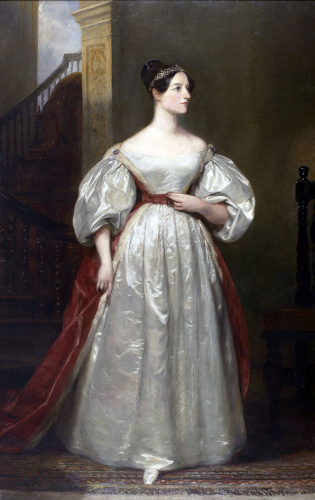
Ada Lovelace, the first computer programmer
Amongst her correspondence with Babbage about the Analytical Engine, she debunked the idea (often still attributed to modern computers) that the machine was "thinking," arguing that "The analytical Engine has no pretentions whatever to originate anything, it can do whatever we know how to order it to perform". Ada's notes end with note G, which put her in the history books. Note G contains instructions for computing Bernoulli numbers via the Analytical Engine. This program was more complex and advanced than anything Babbage himself had written for the engine, and is widely accepted as the first computer program.
Note G, The first published computer program, written by Ada Lovelace
In the late 19th century, statistician Herman Hollerith used the idea of using punched cards to store information when he created a punch card tabulating machine that he used to input data for the 1890 U.S. Census. Hollerith’s Tabulating Machine Company would later change its name to International Business Machines; IBM for short.
The use of binary code in weaving illustrates the way that ideas and concepts can be passed down through history and inspire new innovations. The use of binary code in weaving, and later in computer science and engineering, demonstrates the power of interdisciplinary thinking and the value of looking to the past to inform the future.
The Apollo Missions
Many things may come to mind when you think of the Apollo Missions; feats of engineering, unfathomable bravery, a space race that shook the world. But that one small step for man wouldn't have happened if not for the many women charged with completing intricate and challenging handiwork as part of integrated circuits and manually woven core memory.
The Apollo Guidance Computer. Source: Hackaday
When President Kennedy announced the US's mission to the moon in 1962, computers were large mainframes that took up entire rooms. The challenge for NASA was to create an onboard computer that was reliable and powerful enough to control a moon mission, but also portable enough to go along for the ride. NASA decided to use integrated circuits in the Apollo Guidance Computer. Integrated circuits are tiny electronic devices that contain multiple electronic components, such as transistors, resistors, and capacitors, all fabricated on a single piece of semiconductor material.
The fabrication of integrated circuits is a complex process that requires a high degree of precision and accuracy. In the early days of integrated circuit technology, this fabrication was done by hand, and highly skilled workers were necessary.
A brochure commemorating the dedication of Fairchild Semiconductor’s plant in Shiprock, N.M., included this Fairchild 9040 integrated circuit. Source: Computer History Museum
Many Navajo women were recruited to work at the Fairchild Semiconductor plant in Shiprock, New Mexico, which was located on Navajo land. Fairchild was big into outsourcing, and they hired a lot of workers off the reservation due to their search for low cost labor inside the US. Many of the women spoke Navajo as their first language and had little formal education, but they were highly skilled in the traditional Navajo craft of weaving. The weaving skills they had honed over many years translated well to the delicate work of assembling and testing integrated circuits.
The women worked in teams, with one person responsible for each step in the fabrication process. They used magnifying glasses and small tools to carefully place and connect the tiny components, working in a clean environment to prevent contamination. The work was tedious and demanding, and the women were known for their high level of skill and precision.
Navajo woman using a microscope in a fabrication lab. Source: Computer History Museum
The integrated circuits created by these Navajo women were used in a variety of applications, including the guidance and control systems used in the Apollo spacecraft. Their contributions were essential to the success of the Apollo missions, and they represent an important chapter in the history of space exploration.
Across the country at the same time, another group of women were contributing to the moon mission at Raytheon in Boston. During the 1960s and early 1970s when the Apollo missions were taking place, computer technology was still in its early stages and the memory storage options were limited. Magnetic core memory, which used tiny magnetic rings (cores) to store information, was one of the most advanced and reliable forms of computer memory available.
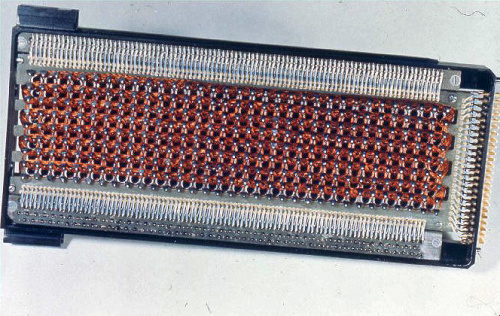
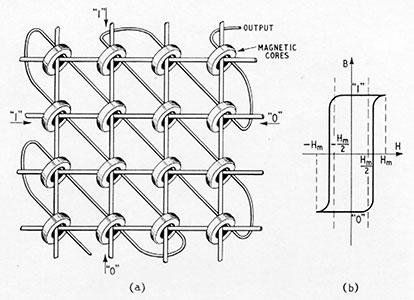
Core rope memory from the Apollo Guidance Computer
Core rope memory works by magnetizing small rings with an electric current. Source: T.E. Ivall
Each core represents a single bit of information, which can be either a 1 or a 0. The magnetic cores are made of a magnetic material such as ferrite, and they are arranged in a grid pattern on a rectangular plane. To store information, an electrical current is passed through a wire that runs through a specific core, which magnetizes the core in one direction or the other, representing a 1 or a 0. To read the information, a sensing wire is used to detect the magnetic field of the core. If the magnetic field is present, it represents a 1, and if it is not present, it represents a 0.
This type of memory was read-only, and the programs it held were developed on a large computer located at the MIT Lab, then translated into a code that it then punched into perforated tape. This was then fed into a machine that positioned the cores for proper threading.
"Common #7 needle and 00 thread dwarf cores and wires in typical section of Ampex computer memory. Each core stores unit of computer data. Three wires go through center of each core."- Popular Electronics, February 1972
The memory cores were tiny magnetic rings, each smaller than a sewing needle, that were woven together by hand using a process called "core rope memory." This process involved threading small magnetic rings onto wires in a specific pattern, with each ring representing a "bit" of information. The wires were then woven together to create a durable and reliable memory storage system that could withstand the extreme temperatures and conditions of space travel.
Weaving memory cores by hand was a meticulous process. Source: AmusingPlanet
The women who worked on weaving the memory cores were highly skilled and meticulous, as the accuracy of the weaving was critical to the performance of the memory system. They worked long hours in specialized facilities, carefully threading the magnetic rings onto the wires and weaving them together to create the final memory cores.
Woman weaving core memory
The accuracy of their work was so important, it needed to be approved by several people before completion. Despite the important role they played in the success of the Apollo missions, the women who worked on the memory cores were largely unrecognized at the time.
One woman who supervised this project is Margaret Hamilton, who oversaw much of the software development for the Apollo Guidance Computer and had to identify and fix errors. The accuracy of the software was her responsibility, and although her efforts were not well recognized at the time, she has since received the Presidential Medal of Freedom.
Margaret Hamilton with the Apollo Guidance Computer source code. Source: NASA
About her work on the project, Margaret has said “At the beginning, nobody thought software was that big a deal. But then they began to realize how much they were relying on it…. Astronauts‘ lives were at stake. Our software needed to be ultrareliable and it needed to be able to detect an error and recover from it at any time during the mission. And it all had to fit on the hardware.”
The work women were doing on the Apollo missions was incredibly important to the success of the journey to the moon, but it wasn't treated like it at the time. Fairchild Semiconductors described the work of the Navajo women as a labor of love, and made sure to differentiate their work as a "feminine craft" not to be confused with engineering, which was considered masculine and more high-status. Similarly, the guy in charge of the Apollo Guidance Computer's hardware design referred the the Raytheon employees who wove the computer's memory by hand as "tender loving care," and presented this work as requiring no thinking and no skill, which couldn't be farther than the truth.
JoAnn Morgan was the only woman engineer among scores of men in the Firing Room at the Kennedy Space Center on July 16, 1969, after the Apollo 11 spacecraft launched. Today, women make up 34% of NASA's workforce. Credit: NASA
A 1975 NASA report that summarized the Apollo missions spoke very highly of the Apollo computing systems, but failed to mention any of the Navajo or Raytheon women. “The performance of the computer was flawless,” the report said. “Perhaps the most significant accomplishment during Apollo pertaining to guidance, navigation, and control was the demonstration of the versatility and adaptability of the computer software.”
That computer and its software relied on the skilled and technical labor and expertise of thousands of women, including women of color. They were without a doubt women of science, and their untold stories encourage us to reconsider what exactly counts as scientific expertise, and why this type of technical labor has only been considered science when men do it.
Computers as "men's work"
Minimizing the effort and technicality of women's work on software has unfortunately been a common theme throughout history. Today, computer science and engineering is a male dominated field and has a reputation as a highly technical and difficult industry, a far cry from the secretarial reputation it held back when most programmers were women. They were sought after for stereotypically being logical, skilled at mathematics, and detail oriented, and although they were at the cutting edge of new technology and contributing to large scale innovations, their work wasn't looked at that way.
The ENIAC (Electronic Numerical Integrator and Computer) was the first programmable computer, and its operations were integral to the US's involvement in World War II. It could be programmed to perform complex sequences of operations, including loops, branches, and subroutines. It was also programmed by a team of six women: Kay McNulty, Betty Jennings, Betty Snyder, Marlyn Meltzer, Fran Bilas, and Ruth Lichterman. All were heavily involved, highly accomplished, and irreplacable in their positions, yet some of the women did not receive recognition for their work on the ENIAC in their lifetimes.
Programmers Betty Jean Jennings and Fran Bilas operate ENIAC's main control panel. Source: US Army
The labor shortage created by World War II helped enable the entry of women into the field of programming, as it had originally been deemed unsuitable for women. The field was not viewed as prestigious, and bringing in women was seen as a way to free men up for more "skilled" labor. However, after the war ended, the women continued to work on the ENIAC because they were so good at it. Their expertise made their positions difficult to replace with returning soldiers.
Women's history has been intertwined with the history of computer science and engineering for as long as they have both existed; using binary logic in textile weaving, painstakingly threading together computer memory by hand to get us to the moon, and programming the first computers. Women have been doing analytical and logical science for centuries and have been at the forefront of countless innovations in the field, and it's about time we start learning more about their contributions and celebrating them for the scientists they are.
Further resources
Want to keep learning? Check these out:
Research paper on the Navajo women's experience: Indigenous Circuits: Navajo Women and the Racialization of Early Electronic Manufacture by Lisa Nakamura.
On the transition of computer science from a female-dominated field to what it is today, as well as profiles on some of the earliest women programmers: The Secret History of Women in Coding from the New York Times in 2019.
Wikipedia has compiled a full timeline of Women in Computing.
A look at multimedia artist Ahree Lee's interdisciplinary exhibit "Pattern : Code" in Weaving, coding, and the secret history of ‘women’s work’
Happy Women's History Month!
We want to hear about your work and what women have inspired you through their inventions and hard work. Shoot us a tweet @sparkfun, or let us know on Instagram, Facebook or LinkedIn.
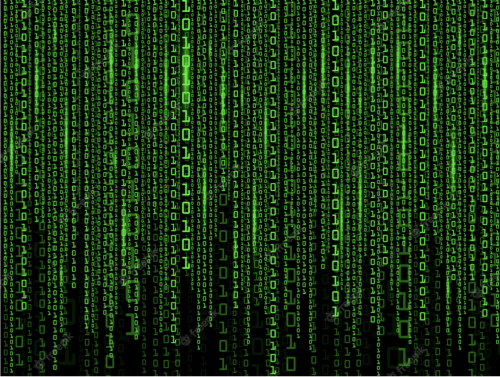


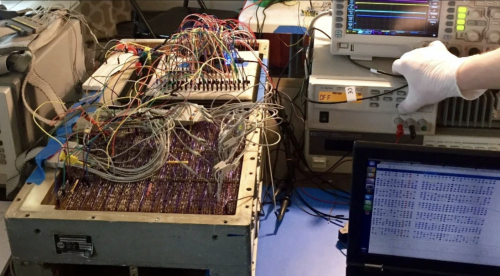
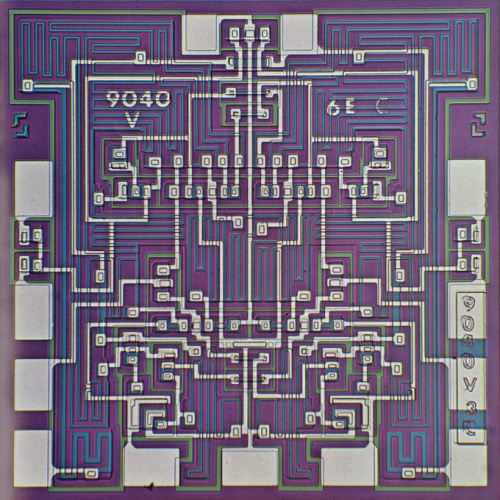
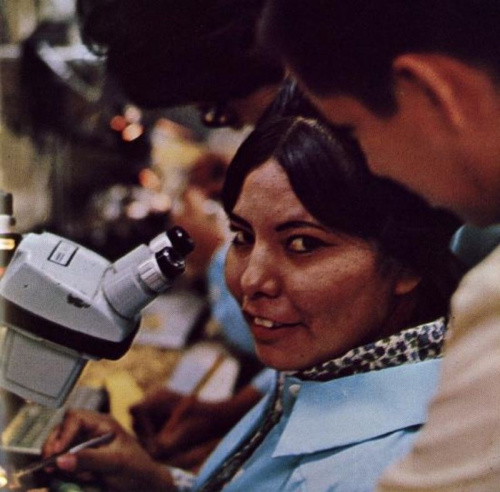
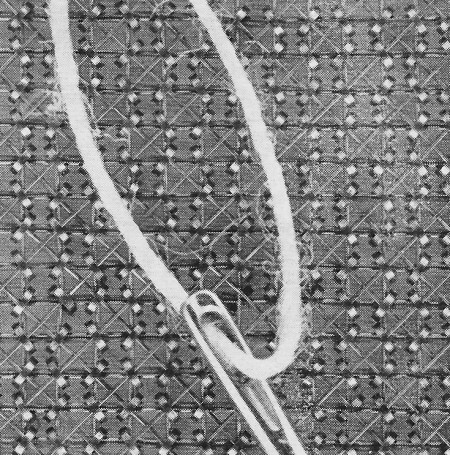
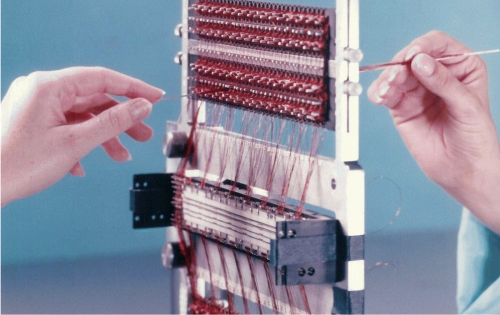

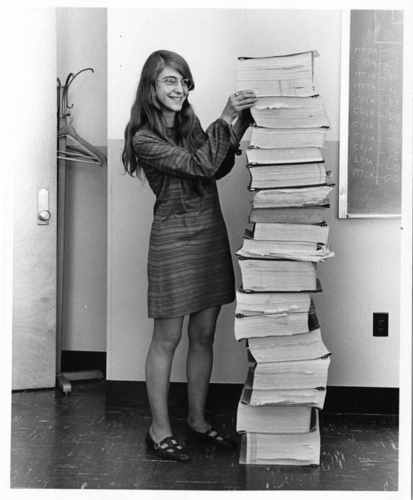
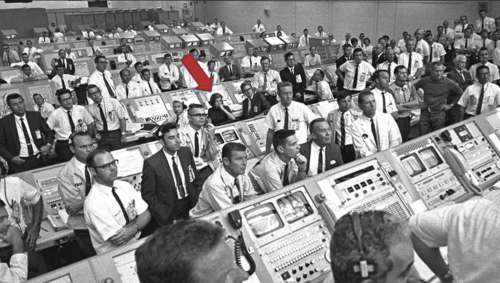
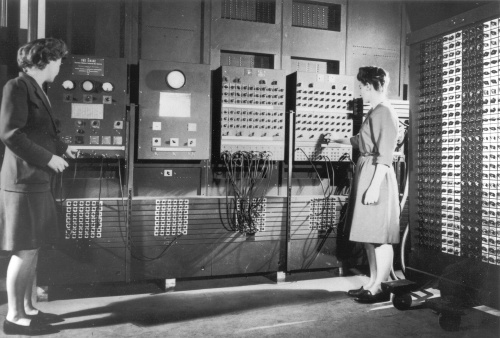







Really great article. I'm a high school computer science teacher and this is a great resource both for us but also for our First Nations studies teachers. My mother in law is 104 and she was one of Canada's first computer programmers. Told us stories of in the 1950s, having to write her programs in Toronto and then take a train to Boston or New York to be able to run the programs and get the results. Great history!
Great article - thanks for presenting in such an engaging way. Many years ago I programmed in Ada - it was great to read the back story of such a pivotal and groundbreaking woman!
Let me start by saying that you did present a good article, HOWEVER, I do have a few issues with it.
First is that you failed to mention Grace Hopper who played a very important role in the history of computing.
Second, there's good reason why the NASA report "failed to mention" the contribution of the Navajo ladies: they could not have participated in the manufacture of parts for Apollo, based on the timeline: the actual computers were completed around the end of 1965, and if you go with the dates in Ms. Nakamura's paper, they weren't working on semiconductor assembly until a year later, though I also take issue with her date, as I've found mention that the Window Rock plant opened about the time that Apollo 11 returned to earth.
You also have some confusion about magnetic core memory. There are two forms of magnetic core memory: Using the lingo from the early 1960s, there's "writable store" (or what today is called "RAM") and "non-writeable store" (also referred to as "rope memory", which is a form of ROM in today's lingo). The hand drawing is NOT for rope memory, but for RAM. In RAM, each core stores 1 bit and with most designs, each core has three wires running through it -- two drive wires and one sense wire. The cores for RAM are extremely small -- around 0.06", or roughly the size of the 0 in the date on a Lincoln Head Penny. For the ROM "rope" memory, each core "stores" several bits, usually with all of the bits for a given word of memory being associated with a single core. There will be two or more drive wires, plus a sense wire for each bit -- if the since wire goes through a given core then it represents a 1 for that word and if it goes around the core rather than through it it represents a 0. (This works because the torroidial shape of the core means that most of the magnetic field is contained within the core -- so when it "flips" it generates a detectable current in the sense wires that go through it, but does NOT generate the current in the wires that go around it. The drive wires are arranged such that only one core will "flip" at a time.) The cores for "rope" memory were not nearly as small -- about 5/16" outside diameter. The "Block II" Apollo Guidance Computers which flew on every manned mission had 2K words of RAM and 36 K words of ROM -- and the computer used a 15 bit word size (yes, that's very strange to modern minds, but there were reasons for it).
I might mention that I first started "doing" computers a few weeks after Neil Armstrong took his "small step", and I'll also mention that researching the Apollo Guidance System was one of my "Covid lock-down" projects, so I devoted a fair amount of time to it. I've also built a small (32 bit) core memory RAM (as an Arduiino sheild) from a no-longer-available kit. By far the hardest part of that was stringing the wires through the 32 cores! I greatly admire the ladies who did this for a living -- it took me 4 separate sessions to get all 32 of mine done.